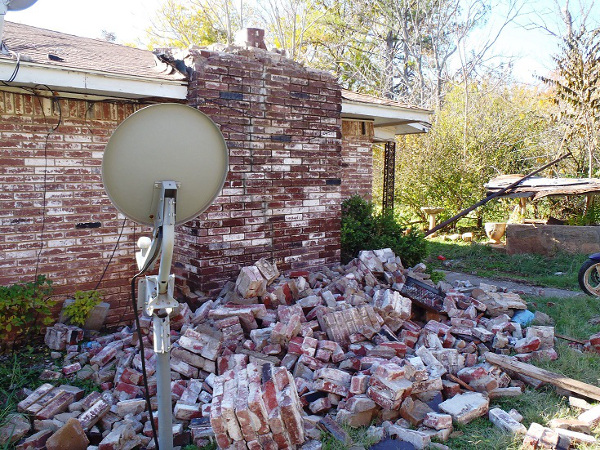The locals call it "incoming," and some compare the violence of the tremors to living in a war zone.
Others say it's like having their homes hit by a truck.
The scene is north Texas, home to the Barnett Shale, the largest unconventional gas field in the United States.
There, industry, often touted as the new engine of the U.S. economy, has punctured and fractured the landscape with 17,000 gas wells, as well as thousands of disposal sites to get rid of related toxic waste fluids.
It's in north Texas where the unconventional gas industry, together with what it calls the "safe and proven" practice of hydraulic fracturing, has been making unconventional, earth-shattering headlines.
In the last three months, the community of Azle, located just northwest of Fort Worth, has suffered a swarm of earthquakes -- more than 30 -- that has cracked the foundations of the houses, frightened local residents, created sinkholes and raised concerns about property values.
Five quakes in January alone ranged from a magnitude of 2.3 to 3.1.
"We're sitting there, and 11:40, it rumbled right on through the house," Azle resident Tracy Strickland told KERA news, a public broadcaster in north Texas earlier this month.
"It feels like a truck hits the back of the house, and the whole house just shakes. So, it's something."
In many respects the Texas tremors, along with significant earthquakes in Groningen, Holland, offer a glimpse of the geological challenges that will accompany massive drilling activity in northern British Columbia to support the provincial government's scheme to export unconventional gas to Asia.
After an angry town hall meeting in early January, the Railroad Commission of Texas, the state's oil and gas regulator, vowed to hire an earthquake specialist to study the phenomenon. It initially denied any connection between tremors and oil and gas activity.
"No disrespect, but this isn't rocket science here," Lynda Stokes, the mayor of Reno, Texas (a community near Azle) recently told officials at a 300-strong protest in the state capitol, Austin. "Common sense tells you the wells are playing a big role in all this."
Quaking and fracking
So, too, does the science.
A string of studies, including one by B.C.'s Oil and Gas Commission, have not only implicated hydraulic fracturing but the related practice of pumping dirty wastewater deep underground as the cause of unprecedented swarms of earthquakes in Ohio, Arkansas, Oklahoma, Texas, B.C. and even Alberta.
A recent study by the U.S. Geological Survey (USGS) found that the rate of earthquakes greater than a magnitude of three has steadily increased in the U.S. Heartland since 2001, the beginning of the shale gas boom, "culminating in a six-fold increase over 20th century levels in 2011."
"While the seismicity rate changes described here are almost certainly manmade, it remains to be determined how they are related to either changes in extraction methodologies or the rate of oil and gas production," concluded the study.
Studies in England, Oklahoma and B.C. have pointedly implicated hydraulic fracturing as earthquake triggers too.
A 2011 fracking operation in the Bowland Shale near Blackpool, England set off 50 minor earthquakes.
In B.C. the industry, which uses three times more water and often at higher pressures than other shale gas formations, set off more than 200 quakes in the Horn River Basin between April 2009 and Dec. 2011.
At least 19 of the quakes ranged between a magnitude of two and three, and one reached a magnitude of 3.8, an event that surprised most scientists.
Compared to other forms of man-made quaking activity such as dam building, conventional oil and gas field depletion, water injection for geothermal energy recovery, and wastewater disposal, hydraulic fracturing was only supposed to make very small earthquakes.
The tremors caused by fracking all took place after high-pressured pumping of fluids either connected to natural faults or created fractures to the fault.
The B.C. Oil and Gas Commission concluded that that the quakes were indeed "induced by fault movement resulting from injection of fluids during hydraulic fracturing." Moreover, the man-made quakes likely resulted in "two instances of wellbore deformation" within the horizontal well portion of target zones.*
As a result the Commission has started a broader study along with the University of British Columbia to look at "factors related to the extent, magnitude, impact and control of induced seismicity in northeast B.C."
Another culprit: wastewater
In Azle, Texas and other shale fractured landscapes, scientists suspect the culprit may not be fracking but its companion industry: dirty water disposal.
A 2012 study by Cliff Frohlich, a senior researcher at the University of Texas in Austin, noted that a swarm of tremors in the Barnett Shale near Dallas were all located near deep well disposal sites.
"You can't prove that any one earthquake was caused by an injection well," said Frohlich. "But it's obvious that wells are enhancing the probability that earthquakes will occur."
William Ellsworth, a geophysicist with the USGS, argues that several of the largest earthquakes in the U.S. Mid-continent in 2011 and 2012 were probably triggered by the practice of disposing of salt and drilling fluids more than 10,000 feet underground in disposal wells.
At these depths the waste fluids can destabilize and lubricate natural faults beyond their tipping point.
While extracting oil and gas, the petroleum industry yearly produces between 15 to 20 billion barrels of highly toxic wastewater contaminated with salt, heavy metals hydrocarbons and radioactive material.
The U.S. Argonne National Laboratory, for example, reports that aging U.S. wells produce an average of more than seven barrels of water for each barrel of oil. Meanwhile, 260 barrels of water are produced for every million cubic feet of natural gas.
Industry injects most of this toxic brew back underground. But the fracking industry has exponentially increased the amount of toxic water needing disposal.
Pumping these wastes permanently underground remains a big and uncertain business. Texas operates more 50,000 injection wells, five of which are located near Azle, the state's new earthquake centre.
Alberta has nearly 2,000 injection well sites and Oklahoma, which experienced a record 2,600 quakes last year, is home to 5,000 injection sites. As of 2007, B.C. employed more than 100 wastewater wells in its gas fields.
Many of continent's more than 680,000 injection and disposal wells have sprung leaks or have fractured into aquifers.
Since the advent of hydraulic fracturing of shale gas plays in northern B.C., the volume of water disposed by the industry through deep injection wells has grown from approximately 1.2 billion litres in 1990 to 4.2 billion litres in 2009 -- an average increase of seven per cent per year.
Hyper hydrocarbons
Geologists have known for years that various forms of hydrocarbon production, from drilling and pumping to injecting and fracturing, can cause man-made earthquakes. Experts call the phenomenon "induced seismicity."
One 2013 study found that large earthquakes in Japan and Chile were now unsettling injection waste disposal sites in Oklahoma, Texas and Colorado, creating smaller earthquakes.
"The remote triggering by big earthquakes is an indication the area is critically stressed," said author Nicholas van der Elst, a researcher at Columbia University's Lamont-Doherty Earth Observatory.
The natural gas industry sparked a swarm of major earthquakes in the 1970s and '80s in central Alberta. The rapid draining of a sour gas field near Rocky Mountain House triggered as many as 146 quakes in one year.
Oil sands waste disposal in Cold Lake, Alberta triggered earthquakes in the '60s and '80s.
The natural gas industry also shook up Gazli, Uzbekistan with earthquakes as high as 7.3 on the Richter scale in the '70s.
Russian scientists concluded that a series of major quakes were "the strongest of all the known earthquakes in the plain of Central Asia" and that "the amassed data indicate that the Gazli earthquakes were triggered by the exploitation of the gas field."
But the with the advent of multi-stage horizontal hydraulic fracturing, which injects large volumes of water and chemicals at extremely high pressures much deeper underground than ever before and produces enormous amounts of waste fluids, the industry has set off earthquakes with startling regularity.
Even the U.S. Army Corp of Engineers, which is responsible for the safety of 640 dams, is getting alarmed. It has requested 3,000-ft buffer zones around dams and other impoundments due to worries about tremors caused by multi-stage horizontal fracturing.
Corp engineers fear that fracking could cause shifts along natural faults and weaken dam foundations.
They suspect that "poorly controlled hydrofracturing" or "breakouts" could erode "the embankment along existing faults located in the foundation, abutments or outlet works," leading to a dam failure.
A 2013 study by the Alberta Geological Survey shows that earthquake activity in the hydrocarbon rich province has increased from an average of 20 minor quakes a year to more than 40 from 2000 to 2010.

In particular, clusters of tremors have increased in areas of ramped-up tight oil activity and multi-stage hydraulic fracking, such as Brazeau County and Del Bonita near the Montana border.
Landowners have also reported structural damage from tremors in Cochrane, Ponoka and Strathmore, where intense fracking has taken place.
As a consequence, the government of Alberta quietly issued controls on fracking around critical infrastructure and imposed severe restrictions on activity near the Brazeau Dam after lobbying by TransAlta pressed for tighter regulations last year.
The Dutch danger
Meanwhile, a series of earthquakes in northern Holland, under Europe's largest and oldest natural gas field, illustrate another geological danger posed by the gas industry.
There the issue isn't fracturing, but the rate and volume of gas that the industry has sucked out of the ground, down to depths of 2,900 metres underneath the Dutch province of Groningen.
So much gas has been pumped out that the land is now collapsing or subsiding which, in turn, has triggered a series of devastating quakes as high as four in magnitude.
More than 60 per cent of 60,000 homes in northern Holland have now been damaged by scores of recent earthquakes directly induced by the gas industry.
One significant quake recently shook a dyke holding back the North Sea and sparked protests from thousands of frightened landowners.
Several decades ago, the rate of gas extraction triggered an average of 20 tremors a year. Now the quakes average one a week.
The Nederlandse Aardolie Maatschappij (NAM), a gas consortium including Royal Dutch Shell and Exxon Mobil Corpgas, admits it is dealing with more than 6,000 damage claims.
Daniella Blanken, a director of a protest group known as the Groningen Ground Movement, told the BBC last year that the quakes were growing more intense.
"It comes rumbling towards you, louder and louder and louder. Everything starts to shake. It ends with a bang, like a massive weight dropped on the house. Boof! And that is frightening, really really frightening," she said.
As a consequence of the increase in earthquake swarms as well as public protests, the Dutch government reluctantly ordered a reduction in the field's production by 15 to 20 per cent.
The Dutch government, which earned $12 billion in Euros from Groningen gas production, said it will also pay $1.6 billion in damages to homeowners. Without gas revenue, the Dutch economy would be as indebted as that of Cyprus.
*Story corrected Jan. 31 at 6 p.m. ![]()
Read more: Energy, Labour + Industry, Environment

















Tyee Commenting Guidelines
Comments that violate guidelines risk being deleted, and violations may result in a temporary or permanent user ban. Maintain the spirit of good conversation to stay in the discussion.
*Please note The Tyee is not a forum for spreading misinformation about COVID-19, denying its existence or minimizing its risk to public health.
Do:
Do not: